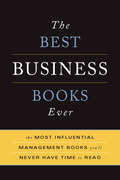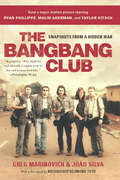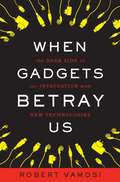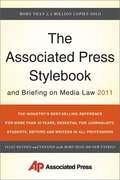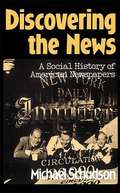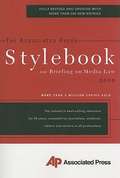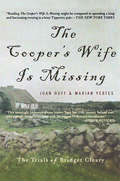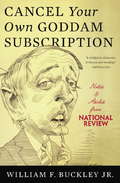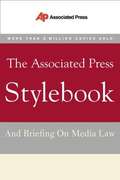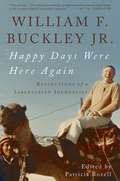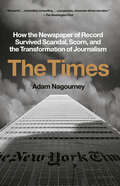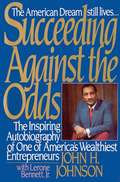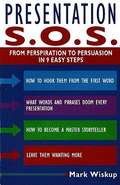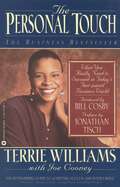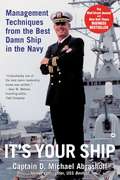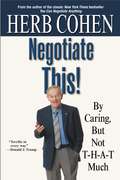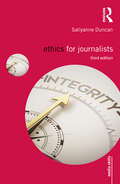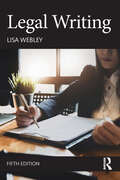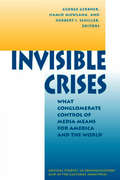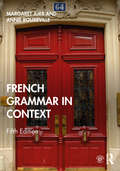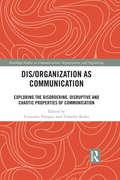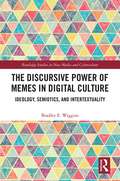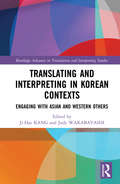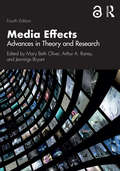- Table View
- List View
The Best Business Books Ever: The 100 Most Influential Management Books You'll Never Have Time To Read
by Basic BooksEvery manager could benefit from a solid grounding in the history and evolution of business thinking. The Best Business Books Everis a uniquely organized guide and an illuminating collection of key ideas from the 130 most influential business books of all time. It places both historical and contemporary works in context and draws fascinating parallels and points of connection. Now fully revised and more than 30 percent bigger, this one book highlights the information you need to know and why it's important to know it, and does it all in a succinct, time-saving fashion. Business moves faster than ever these days. For the businessperson who has a growing list of tomes that they can never quite seem to get to,The Best Business Books Everis a must-have.
The Bang-Bang Club: Snapshots From a Hidden War
by Greg Marinovich Joao Silva Archbishop Desmond TutuA gripping story of four remarkable young men—photographers, friends and rivals—who band together for protection in the final, violent days of white rule in South Africa.
When Gadgets Betray Us: The Dark Side of Our Infatuation With New Technologies
by Robert VamosiWriting in plain language for general readers, Vamosi, a computer security analyst and a contributing editor at PCWorld, explains what we're really signing up for when we log in and reveals the secret lives of our electronic devices, offering a commonsense approach for protecting ourselves. The book is about hardware hacking and new kinds of identity fraud: how our mobile phone conversations can be intercepted, how our credit cards and driver's licenses can be copied at a distance. The author travels from the streets of New York and LA to Johannesburg and Berlin, to talk to people who have experienced firsthand how gadgets can betray us and to examine the effects of technology in the Third World. He recommends the addition of basic authentication and strong encryption to most hardware to reduce the vulnerabilities described in the book, but notes that hardware manufacturers have so far shown little interest in securing their gadgets. Annotation ©2011 Book News, Inc. , Portland, OR (booknews. com)
The Associated Press Stylebook and Briefing on Media Law (2011 Edition)
by Associated PressThe style of the Associated Press is the gold standard for news writing. With The AP Stylebook in hand, you can learn how to write and edit with the clarity and professionalism for which they are famous.
Discovering The News: A Social History Of American Newspapers
by Michael SchudsonThis instructive and entertaining social history of American newspapers shows that the very idea of impartial, objective "news" was the social product of the democratization of political, economic, and social life in the nineteenth century. Professor Schudson analyzes the shifts in reportorial style over the years and explains why the belief among journalists and readers alike that newspapers must be objective still lives on.
AP Associated Press Stylebook and Briefing on Media Law (44th edition)
by Norm GoldsteinThe style of the Associated Press is the gold standard of news writing. With The AP Stylebook in hand, you can learn to write with the clarity and professionalism for which the Associated Press is famous. Fully revised and updated, this new edition contains more than 3,000 A to Z entries-including more than 200 new ones-detailing the AP's rules on grammar, spelling, punctuation, capitalization, abbreviation and word and numeral usage. New entries include anti-spyware, high-definition, iPhone, outsourcing, podcast, text messaging, social networking, snail mail, WMD and Wikipedia. You'll also find answers to such widespread questions as: How should bankruptcy and mergers and acquisitions be covered? When should the names of government bodies or businesses be spelled out and when should they be abbreviated? What are the general definitions of the major religious movements? Which companies do the big media conglomerates own? Who are all the members of the British Commonwealth? What constitutes "fair use"? How should box scores for baseball games be filed, and how should sports terms like mini camp and wild card be used What exactly does the Freedom of Information Act cover? With invaluable additional sections on the unique guidelines for business and sports reporting and on how you can guard against libel and copyright infringement, The AP Stylebook is the one reference that all writers, editors and students cannot afford to be without.
The Cooper's Wife Is Missing
by Joan Hoff Marian YeatesIn 1895 twenty-six-year-old Bridget Cleary disappeared from her cottage in rural County Tipperary and remained missing for several days. At last her body was discovered, bent, broken, and badly burned in a shallow grave. Within a few days, her unimaginable story came to light: for almost a week before her death she had been confined, starved, threatened, physically and verbally abused, exorcised, and finally burned to death by her husband, father, aunt, cousins, and neighbors, who had collectively confused a simple flu with possession by the fairies. In The Cooper's Wife Is Missing, Joan Hoff and Marian Yeates try to make sense of this outlandish, unfathomable, medieval "trial" and murder. Drawing on firsthand accounts, contemporary newspaper reports, police records, trial testimony, and a rich wealth of folklore, they weave a mesmerizing fireside tale of magic, madness, and mystery. This is narrative history at its evocative best.
Cancel Your Own Goddam Subscription: Notes and Asides from National Review
by William F. Buckley Jr.National Review has always published letters from readers. In 1965 the magazine decided that certain letters merited different treatment, and William F. Buckley, the editor, began a column called "Notes & Asides” in which he personally replied to the most notable and outrageous correspondence. Culled from four decades of the column, Cancel Your Own Goddam Subscription includes exchanges with such well-known figures as Ronald Reagan, Richard Nixon, John Kenneth Galbraith, A. M. Rosenthal, Auberon Waugh, Arthur Schlesinger Jr. , and many others. There are also hilarious exchanges with ordinary readers, as well as letters from Buckley to various organizations and government agencies. Combative, brilliant, and uproariously funny, Cancel Your Own Goddam Subscription represents Buckley at his mischievous best.
AP Associated Press Stylebook and Briefing on Media Law (42nd edition)
by Norm GoldsteinMore people write for The Associated Press than for any newspaper in the world, and writers--nearly two million of them--have bought more copies of the AP Stylebook than of any other journalism reference. It provides facts and references for reporters, and defines usage, spelling, and grammar for editors. There are separate sections for journalists specializing in sports and business, and complete guidelines for how to write photo captions, file copy over the wire, proofread text, handle copyrights, and avoid libel. This edition of the AP Stylebook keeps pace with world events, common usage, and AP procedures.
Happy Days Were Here Again: Reflections of a Libertarian Journalist
by William F. Buckley Jr.In "Happy Days Were Here Again", William F. Buckley Jr. offers a collection of his finest essays from the latter part of his long career. Sometimes celebrating, sometimes assailing, Buckley takes on opponents ranging from Mikhail Gorbachev to Carl Sagan to Leonard Bernstein; reflects on the academic scene, the Gulf War, and the idea of sin; and offers appreciations of friends, both right and left. For everyone who appreciates the wit and style of America's preeminent conservative, this is a must-have collection.
The Times: How the Newspaper of Record Survived Scandal, Scorn, and the Transformation of Journalism
by Adam NagourneyA sweeping behind-the-scenes look at the last four turbulent decades of &“the paper of record,&” The New York Times, as it confronted world-changing events, internal scandals, and faced the existential threat of the internet &“An often enthralling chronicle [that] delivers the gossipy goods . . . Like Robert Caro&’s biographies, [The Times] should appeal to anyone interested in power.&”—Los Angeles TimesA KIRKUS REVIEWS BEST BOOK OF THE YEARFor over a century, The New York Times has been an iconic institution in American journalism, one whose history is intertwined with the events that it chronicles—a newspaper read by millions of people every day to stay informed about events that have taken place across the globe.In The Times, Adam Nagourney, who&’s worked at The New York Times since 1996, examines four decades of the newspaper&’s history, from the final years of Arthur &“Punch&” Sulzberger&’s reign as publisher to the election of Donald Trump in November 2016. Nagourney recounts the paper&’s triumphs—the coverage of September 11, the explosion of the U.S. Challenger, the scandal of a New York governor snared in a prostitution case—as well as failures that threatened the paper&’s standing and reputation, including the discredited coverage of the war in Iraq, the resignation of Judith Miller, the plagiarism scandal of Jayson Blair, and the high-profile ouster of two of its executive editors.Drawing on hundreds of interviews and thousands of documents and letters contained in the newspaper&’s archives and the private papers of editors and reporters, The Times is an inside look at the essential years that shaped the newspaper. Nagourney paints a vivid picture of a divided newsroom, fraught with tension as it struggled to move into the digital age, while confronting its scandals, shortcomings, and swelling criticism from conservatives and many of its own readers alike. Along the way we meet the memorable personalities—including Abe Rosenthal, Max Frankel, Howell Raines, Joe Lelyveld, Bill Keller, Jill Abramson, Dean Baquet, Punch Sulzberger and Arthur Sulzberger Jr.—who shaped the paper as we know it today. We see the battles between the newsroom and the business operations side, the fight between old and new media, the tension between journalists who tried to hold on to the traditional model of a print newspaper and a new generation of reporters who are eager to embrace the new digital world.Immersive, meticulously researched, and filled with powerful stories of the rise and fall of the men and women who ran the most important newspaper in the nation, The Times is a definitive account of the most pivotal years in New York Times history.
Keeping in Touch
by Ellen GoodmanIn these columns of the past four years, Goodman writes about people, issues and popular inanities with a skill that makes her a master of the 750-word form.She brings us from Liz Taylor's need for "privacy," to aerial burials, to the Nancy Drew books, to thoughtful examinations of AIDS and other controversial topics of concern.
Succeeding Against the Odds
by John J. Johnson Lerone Bennett Jr.Story of the most successful black American businessman, John H. Johnson.
Presentation S.O.S.: From Perspiration to Persuasion in 9 Easy Steps
by Mark WiskupEverything you need to make your next talk a resounding success is right here-even if you dread the thought of approaching a podium! In Presentation S.O.S., renowned communications expert Mark Wiskup gives you a quick, concise, and (yes!) fun way to confidently sell your ideas to any audience. Packed with unique tips and featuring nine easy, painless steps that will transform you into a great presenter, this book shows you how to: Develop a "Power Sound Bite" to grab your listeners' attention and focus your message. Get the most out of PowerPoint-and dodge its pitfalls. Avoid seemingly harmless words and expressions that can turn the audience against you. Finish big with a knock-'em-dead "Power Close." Win the Q&A battle-learn how to handle even the toughest questions and most difficult members of your audience. Book jacket.
The Personal Touch: What You Really Need to Succeed in Today's Fast-paced Business World
by Terrie WilliamsWilliams, a former social worker and now a successful entrepreneur, speaks here of her personal-touch philosophy and of a unique formula for success that combines a distinctive work ethic, with attention to detail, drive, determination, honesty, and integrity.
It's Your Ship: Management Techniques from the Best Damn Ship in the Navy
by Captain D. Michael AbrashoffThe legendary New York Times bestselling tale of top-down change for anyone trying to navigate today's uncertain business seas. When Captain Abrashoff took over as commander of USS Benfold, it was like a business that had all the latest technology but only some of the productivity. Knowing that responsibility for improving performance rested with him, he realized he had to improve his own leadership skills before he could improve his ship. Within months, he created a crew of confident and inspired problem-solvers eager to take the initiative and responsibility for their actions. The slogan on board became "It's your ship," and Benfold was soon recognized far and wide as a model of naval efficiency. How did Abrashoff do it? Against the backdrop of today's United States Navy, Abrashoff shares his secrets of successful management including: See the ship through the eyes of the crew: By soliciting a sailor's suggestions, Abrashoff drastically reduced tedious chores that provided little additional value. Communicate, communicate, communicate: The more Abrashoff communicated the plan, the better the crew's performance. His crew eventually started calling him "Megaphone Mike," since they heard from him so often. Create discipline by focusing on purpose: Discipline skyrocketed when Abrashoff's crew believed that what they were doing was important. Listen aggressively: After learning that many sailors wanted to use the GI Bill, Abrashoff brought a test official aboard the ship-and held the SATs forty miles off the Iraqi coast. From achieving amazing cost savings to winning the highest gunnery score in the Pacific Fleet, Captain Abrashoff's extraordinary campaign sent shock waves through the U.S. Navy. It can help you change the course of your ship, no matter where your business battles are fought.
Negotiate This!: By Caring, But Not T-H-A-T Much
by Herb CohenThe author of You Can Negotiate Anything (1980), Cohen has been a practicing negotiator for three-plus decades, acting on behalf of U.S. presidents, corporate CEOs, sports and theatrical agents, the U.S. State Department, the CIA, and the FBI. Using a personable, conversational tone, Cohen relays examples from his own experiences as a professional negotiator to give readers insights into human problems and situations and advice for handling them. Annotation (c)2003 Book News, Inc., Portland, OR (booknews.com)
Ethics for Journalists (Media Skills)
by Richard KeebleEthics for Journalists critically explores many of the dilemmas that journalists face in their work and supports journalists in good ethical decision-making. From building trust, to combatting disinformation, to minimizing harm to vulnerable people through responsible suicide reporting, this book provides substantial analysis of key contemporary ethical debates and offers guidance on how to address them. Revised and updated throughout, this third edition covers: the influence of press freedom and misinformation on trust; the novel ethical challenges presented by social media; the need for diversity of sources and in the newsroom, specifically relating to gender, ethnicity, sexual orientation and disability; issues around vulnerable people—reporting traumatic events, bereaved people, suicide and privacy; health journalism and reporting a pandemic; and the impact of regulation on professional standards. Taking an accessible and engaging approach, including expert reflections on personal and professional experience, Ethics for Journalists provides a wealth of insight for those in journalism, from students and trainees to specialist correspondents and experienced editors.
Legal Writing
by Lisa WebleyLegal Writing guides students comprehensively through this vital legal skill and addresses a range of assessment methods from exam questions to final essays and problem answers. It considers how to deconstruct essay and problem questions and how to conduct and apply legal research to answer set questions. Lisa Webley explains how to reference others’ work clearly and correctly, making this book a useful tool for students concerned about issues of plagiarism. Legal Writing also focuses on how to develop critical thinking and communicate legal arguments, with both good and bad examples of written work considered and discussed in the text. Legal Writing is particularly useful for undergraduate students, especially at the beginning of degree studies, as well as for those preparing for the SQE exams. This fully revised fifth edition includes: Guidance on how to avoid plagiarism, including examples of the best and worst practices Worked examples throughout the text, including how to decipher essay questions in exams and coursework An expanded set of accompanying digital learning resources with increased guidance for revision to allow students to test their progress and further engage with the topics in the book. Clearly written and easy to use, Legal Writing enables students to fully engage with essay and exam writing as a vital foundation to their undergraduate degree.
Invisible Crises: What Conglomerate Control of Media Means for America and the World (Critical Studies in Communication and in the Cultural Industries)
by George GerbnerHidden from public sight and mind today are invisible crises that threaten our democracy and existence more than the crises we know about—or think we know about. These invisible crises include the promotion of practices that drug, hurt, poison, and kill thousands every day; cults of violence that desensitize, terrorize, and brutalize; the growing siege mentality of our cities; widening resource gaps and the most glaring inequalities in the industrial world; the costly neglect of vital institutions such as public education and the arts; and media-assisted make-believe image politics corrupting the electoral process.Deprived of sustained attention but bombarded by eruptions of surface consequences (often presented as unique events stripped of historical context), people ar bewildered, fearful, angry, and cynical.The contributors to this volume—exploring such unattended crises, analyzing why they are hidden, and focusing on the increasing concentration of culture-power that keeps them from view—maintain that a profound general crisis of social vision, public communication, and representative government underlies all of the invisible crises.
French Grammar in Context: Analysis And Practice (Languages in Context)
by Margaret Jubb Annie RouxevilleNow in its fifth edition, French Grammar in Context presents a unique and exciting approach to learning grammar. Authentic texts from a rich variety of sources, literary and journalistic, are used as the starting point for the illustration and explanation of key areas of French grammar. Each point is consolidated with a wide range of written and spoken exercises. Grammar is presented not as an end in itself, but as a tool essential to enjoying French, understanding native speakers and communicating effectively with them. Literary texts and poems are taken from renowned French authors such as Albert Camus, Zola, André Malraux, Alain Robbe-Grillet, Stendhal and Jacques Prévert. News sources include Libération, Le Point, Marianne, and Le Monde Diplomatique, in addition to articles from regional papers such as Ouest-France and La Voix du Nord. Lifestyle articles are included from magazines such as Elle. This fifth edition has been updated to include new texts for Chapters 24 and 25 and two new revision texts. In addition, this new edition is supported by a revised and extended companion website that offers a wealth of additional interactive exercises to practise and reinforce the material covered. French Grammar in Context is aimed at intermediate and advanced students and is ideal for both independent and class-based study.
Dis/organization as Communication: Exploring the Disordering, Disruptive and Chaotic Properties of Communication (Routledge Studies in Communication, Organization, and Organizing)
by Consuelo Vásquez Timothy KuhnThis book accounts for the transformation of organizations in a post-bureaucratic era by bringing a communicational lens to the ontological discussion on organization/disorganization, offering a conceptual and methodological toolbox for studying dis/organization as communication. Increasingly, scholars acknowledge that communication is constitutive of organization; because meaning is always indeterminate, communication also (and simultaneously) generates disorganization. The book synthesizes the major theoretical trends and empirical studies in communication that engage with dis/organization. Drawing on dialectics, relational ontologies, critical theory, systems theory, and affect thinking, the first part of the book offers communicational explanations of how dis/organization unfolds. The second part of the book grounds this theoretical reflection, providing empirical studies that mobilize diverse methodological and analytical frameworks (e.g., ethnography, situational, interactional and genre analysis) for studying the practices of dis/organization. Overall, the book exposes organizations (and organizing processes) as significantly messier, irrational (or a-rational), and paradoxical than scholars of organization typically think. It also offers readers the conceptual and methodological tools to understand these complex processes as communication. This book will be essential reading for scholars in organizational communication or management and organization studies, together with senior undergraduate and graduate students studying organizational communication, organizational discourse, discourse analysis (including rhetoric, semiotics, pragmatism, narratology) and courses in management studies. It will also be richly rewarding for organizational consultants, managers and executives.
The Discursive Power of Memes in Digital Culture: Ideology, Semiotics, and Intertextuality (Routledge Studies in New Media and Cyberculture)
by Bradley E. WigginsShared, posted, tweeted, commented upon, and discussed online as well as off-line, internet memes represent a new genre of online communication, and an understanding of their production, dissemination, and implications in the real world enables an improved ability to navigate digital culture. This book explores cases of cultural, economic, and political critique levied by the purposeful production and consumption of internet memes. Often images, animated GIFs, or videos are remixed in such a way to incorporate intertextual references, quite frequently to popular culture, alongside a joke or critique of some aspect of the human experience. Ideology, semiotics, and intertextuality coalesce in the book’s argument that internet memes represent a new form of meaning-making, and the rapidity by which they are produced and spread underscores their importance.
Translating and Interpreting in Korean Contexts: Engaging with Asian and Western Others (Routledge Advances in Translation and Interpreting Studies)
by Judy Wakabayashi Ji-Hae KangThe focus of this volume is on how the people of the Korean Peninsula—historically an important part of the Sinocentric world in East Asia and today a vital economic and strategic site—have negotiated oral and written interactions with their Asian neighbors and Europeans in the past and present through the mediation of translators and interpreters. These encounters have been shaped by political, social, and cultural factors, including the shared use of the Chinese writing system in East Asia for many centuries, attitudes toward other Asians and Westerners, and perceptions of Korean identity in relation to these Others. After exploring aspects of historical interactions, the volume addresses how the role and practice of translation and interpreting have recently evolved as a result of the development of digital technology, an increase in the number of immigrants, and changes in political and cultural dynamics in the region. It covers a range of historical and contemporary aspects, genres, and venues that extend beyond the common yet restrictive focus on literary translation and includes discussions of translator training and academic studies of translation and interpreting in Korea.
Media Effects: Advances in Theory and Research (Routledge Communication Series)
by Jennings Bryant Mary Beth Oliver Arthur A. RaneyNow in its fourth edition, Media Effects again features essays from some of the finest scholars in the field and serves as a comprehensive reference volume for scholars, teachers, and students. This edition contains both new and updated content that reflects our media-saturated environments, including chapters on social media, video games, mobile communication, and virtual technologies. In recognition of the multitude of research trajectories within media effects, this edition also includes new chapters on narratives, positive media, the self and identity, media selection, and cross-cultural media effects. As scholarship in media effects continues to evolve and expand, Media Effects serves as a benchmark of theory and research for the current and future generations of scholars. The book is ideal for scholars and for undergraduate and graduate courses in media effects, media psychology, media theory, psychology, sociology, political science, and related disciplines.
